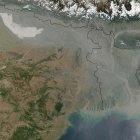
Satellite data shows increasing aerosols over India.
NASA
[NEW DELHI] Aerosols — particles or droplets suspended in the air that impact climate by scattering or absorbing the sun’s radiation — are increasing across India, new research shows.
The findings by S. Ramachandran and colleagues from the space and atmospheric sciences division of the Physical Research Laboratory, Ahmedabad, were published online last month (20 November) in Atmospheric Environment.
Previous Indian studies on aerosols considered India as an entire region or north India as a unit. They also took in just one season, such as winter or the pre-monsoon period from March to May.
In contrast, the new research studied aerosols in 35 locations across India and over the summer and winter seasons, from March 2000 to February 2010.
Scientists measured the 'aerosol optical depth' (AOD), the degree to which aerosols prevent light transmission by absorbing or scattering it, using data from MODIS (MODerate resolution imaging spectrometer), a key instrument aboard two US remote sensing satellites, Terra and Aqua.
They found a rise in annual AOD across 30 locations, while four — Trivandrum in the south and Chandigarh, Dehradun and Shimla in the north — showed a decline. The trends were higher in west and south India.
The annual mean (average) AOD increased by over 40 per cent between 2000 and 2009 in Jaipur, Hyderabad and Bengaluru cities. They rise in AOD over Hyderabad and Bengaluru was attributed to urbanisation, and in Jaipur to increased wind speeds that threw up dust from arid soil.
Similarly, the scientists reported a rise in AOD over New Delhi, attributing it to the burning of fossil fuel and biomass, and an increasing trend in AOD in India’s northeast due to biomass-burning and forest fires.
The study found both AOD and rainfall increased in the last decade in most locations.
"Trends in aerosol characteristics on regional and seasonal scales in India, the focus of this study, are important to examine, understand and explain the effects aerosols have on summer monsoonal rainfall, and the inter-annual variations and trends in rainfall," the report said.
The seasonal and annual trends in AOD over different locations in India will prove useful in the assessments of regional and global climate impact due to aerosols, the scientists concluded.
Jayaraman Srinivasan, chairman of the Divecha Centre for Climate Change and professor at the Centre for Atmospheric and Oceanic Sciences at the Indian Institute of Sciences, Bengaluru, expressed some reservations.
"The use of satellite data to study trends in aerosols over land is not reliable due to the large uncertainties involved in the satellite retrieval of AOD over land," Srinivasan told SciDev.Net.
"One must be wary of mistakenly interpreting noises and biases in satellite aerosol products as legitimate signals in long-term trends analysis," said Srinivasan, who heads a mega Indian research project on black carbon or soot and its environmental impact.
Read in detail at : http://www.cdrn.org.in
No comments:
Post a Comment